Carbon Nanotubes (CNTs) Reinforced CoCrMoNbTi0.4 Refractory High Entropy Alloy Fabricated via Laser Additive Manufacturing: Processing Optimization, Microstructure Transformation and Mechanical Properties
Abstract
1. Introduction
2. Materials and Methods
3. Results and Discussion
3.1. Densification Behavior and Phase Analysis
3.2. Surface Morphology
3.3. Microstructure
3.4. Properties
4. Conclusions
Author Contributions
Funding
Institutional Review Board Statement
Informed Consent Statement
Data Availability Statement
Acknowledgments
Conflicts of Interest
References
- Yeh, J.-W.; Chen, S.-K.; Lin, S.-J.; Gan, J.-Y.; Chin, T.-S.; Shun, T.-T.; Tsau, C.-H.; Chang, S.-Y. Nanostructured high-entropy alloys with multiple principal elements: Novel alloydesign concepts and outcomes. Adv. Eng. Mater. 2004, 6, 299–303. [Google Scholar] [CrossRef]
- Senkov, O.N.; Wilks, G.B.; Miracle, D.B.; Chuang, C.P.; Liaw, P.K. Refractory high-entropy alloys. Intermetallics 2010, 18, 1758–1765. [Google Scholar] [CrossRef]
- Srikanth, M.; Annamalai, A.R.; Muthuchamy, A.; Jen, C.-P. A review of the latest developments in the field of refractory high-entropy alloys. Crystals 2021, 11, 612. [Google Scholar] [CrossRef]
- Wang, Z.; Yan, Y.; Wu, Y.; Huang, X.; Zhang, Y.; Su, Y.; Qiao, L. Corrosion and tribocorrosion behavior of equiatomic refrac-tory medium entropy TiZr (Hf, Ta, Nb) alloys in chloride solutions. Corros. Sci. 2022, 199, 110166. [Google Scholar] [CrossRef]
- Moghaddam, A.O.; Shaburova, N.A.; Samodurova, M.N.; Abdollahzadeh, A.; Trofimov, E.A. Additive manufacturing of high entropy alloys: A practical review. J. Mater. Sci. Technol. 2020, 77, 131–162. [Google Scholar] [CrossRef]
- Zhou, J.-L.; Cheng, Y.-H.; Chen, Y.-X.; Liang, X.-B. Composition design and preparation process of refractory highentropy al-loys: A review. Int. J. Refract. Met. Hard Mater. 2022, 105, 105836. [Google Scholar] [CrossRef]
- Senkov, O.N.; Wilks, G.B.; Scott, J.M.; Miracle, D.B. Mechanical properties of Nb25Mo25Ta25W25 and V20Nb20Mo20Ta20W20 refractory high entropy alloys. Intermetallics 2011, 19, 698–706. [Google Scholar] [CrossRef]
- Zhang, M.; Zhang, B.; Wen, Y.; Qu, X. Research progress on selective laser melting processing for nickel-based superalloy. Int. J. Miner. Met. Mater. 2022, 29, 369–388. [Google Scholar] [CrossRef]
- Liu, Q.; Wang, G.; Sui, X.; Liu, Y.; Li, X.; Yang, J. Microstructure and mechanical properties of ultra-fine grained MoNbTaTiV refractory high-entropy alloy fabricated by spark plasma sintering. J. Mater. Sci. Technol. 2019, 35, 2600–2607. [Google Scholar] [CrossRef]
- Duriagina, Z.; Kulyk, V.; Kovbasiuk, T.; Vasyliv, B.; Kostryzhev, A. Synthesis of functional surface layers on stainless steels by laser alloying. Metals 2021, 11, 434. [Google Scholar] [CrossRef]
- Cai, Y.; Zhu, L.; Cui, Y.; Han, J. Manufacturing of FeCoCrNi + FeCoCrNiAl laminated high-entropy alloy by laser melting deposition (LMD). Mater. Lett. 2021, 289, 129445. [Google Scholar] [CrossRef]
- Dobbelstein, H.; Gurevich, E.L.; George, E.P.; Ostendorf, A.; Laplanche, G. Laser metal deposition of a refractory TiZrN-bHfTa high-entropy alloy. Addit. Manuf. 2018, 24, 386–390. [Google Scholar]
- Chen, S.H.; Zhang, J.S.; Guan, S.; Li, T.; Liu, J.Q.; Wu, F.F.; Wu, Y.C. Microstructure and mechanical properties of WNbMoTaZrx (x = 0.1, 0.3, 0.5, 1.0) refractory high entropy alloys. Mater. Sci. Eng. A 2022, 835, 142701. [Google Scholar] [CrossRef]
- Lu, S.; Li, X.; Liang, X.; Shao, W.; Yang, W.; Chen, J. Effect of Al content on the oxidation behavior of refractory high-entropy alloy AlMo0.5NbTa0.5TiZr at elevated temperatures. Int. J. Refract. Met. Hard Mater. 2022, 105, 105812. [Google Scholar] [CrossRef]
- Li, Q.; Ma, T.; Jin, Y.; Wang, X.; Dong, D.; Zhu, D. Effect of Sn and Mo on microstructure and electrochemical property of TiZrTaNb high entropy alloys. Crystals 2021, 11, 1527. [Google Scholar] [CrossRef]
- Li, Y.; Liang, H.; Nie, Q.; Qi, Z.; Deng, D.; Jiang, H.; Cao, Z. Microstructures and wear resistance of CoCrFeNi2V0.5Tix High-Entropy Alloy Coatings Prepared by Laser Cladding. Crystals 2020, 10, 352. [Google Scholar] [CrossRef]
- Pu, Z.; Cai, S.-L.; Dai, L.-H. Effective strengthening and toughening in high entropy-alloy by combining extrusion machining and heat treatment. Scr. Mater. 2022, 213, 114630. [Google Scholar] [CrossRef]
- Tekin, M.; Polat, G.; Kalay, Y.E.; Kotan, H. Grain size stabilization of oxide dispersion strengthened CoCrFeNi-Y2O3 high entropy alloys synthesized by mechanical alloying. J. Alloys Compd. 2021, 887, 161363. [Google Scholar] [CrossRef]
- Wang, B.; Wang, Q.; Lu, N.; Liang, X.; Shen, B. Enhanced high-temperature strength of HfNbTaTiZrV refractory high-entropy alloy via Al2O3 reinforcement. J. Mater. Sci. Technol. 2022, 123, 191–200. [Google Scholar] [CrossRef]
- Yang, C.; Bian, H.; Aoyagi, K.; Hayasaka, Y.; Yamanaka, K.; Chiba, A. Synergetic strengthening in HfMoNbTaTi refractory high-entropy alloy via disordered nanoscale phase and semicoherent refractory particle. Mater. Des. 2021, 212, 110248. [Google Scholar] [CrossRef]
- Wang, P.; Zhang, B.; Tan, C.C.; Raghavan, S.; Lim, Y.-F.; Sun, C.-N.; Wei, J.; Chi, D. Microstructural characteristics and me-chanical properties of carbon nanotube reinforced Inconel 625 parts fabricated by selective laser melting. Mater. Des. 2016, 112, 290–299. [Google Scholar] [CrossRef]
- Chen, B.; Li, S.; Imai, H.; Jia, L.; Umeda, J.; Takahashi, M.; Kondoh, K. Carbon nanotube induced microstructural characteristics in powder metallurgy Al matrix composites and their effects on mechanical and conductive properties. J. Alloys Compd. 2015, 651, 608–615. [Google Scholar] [CrossRef]
- Iijima, S. Helical microtubules of graphitic carbon. Nature 1991, 354, 56–58. [Google Scholar] [CrossRef]
- Gu, D.; Rao, X.; Dai, D.; Ma, C.; Xi, L.; Lin, K. Laser additive manufacturing of carbon nanotubes (CNTs) reinforced aluminum matrix nanocomposites: Processing optimization, microstructure evolution and mechanical properties. Addit. Manuf. 2019, 29, 100801. [Google Scholar] [CrossRef]
- Li, Q.; Zhang, H.; Li, D.; Chen, Z.; Huang, S.; Lu, Z.; Yan, H. WxNbMoTa refractory high-entropy alloys fabricated by laser cladding deposition. Materials 2019, 12, 533. [Google Scholar] [CrossRef] [PubMed]
- Takeuchi, A.; Inoue, A. Classification of bulk metallic glasses by atomic size difference, heat of mixing and period of con-stituent elements and its application to characterization of the main alloying element. Mater. Trans. 2005, 46, 2817–2829. [Google Scholar] [CrossRef]
- Akira, Y.; Yutaka, K.; Yoshihiro, H. Full width at half maximum intensity of the G band in the first order Raman spectrum of carbon material as a parameter for graphitization. Lett. Ed. Carbon 2006, 4, 2330–2356. [Google Scholar]
- Varillas, J.; Očenášek, J.; Torner, J.; Alcalá, J. Understanding imprint formation, plastic instabilities and hardness evolutions in FCC, BCC and HCP metal surfaces. Acta Mater. 2021, 217, 117122. [Google Scholar] [CrossRef]
- Zhang, M.; Zhou, X.; Zhu, W.; Li, J. Influence of annealing on microstructure and mechanical properties of refractory CoCrMoNbTi0.4 high-entropy alloy. Met. Mater. Trans. A 2018, 49, 1313–1327. [Google Scholar] [CrossRef]

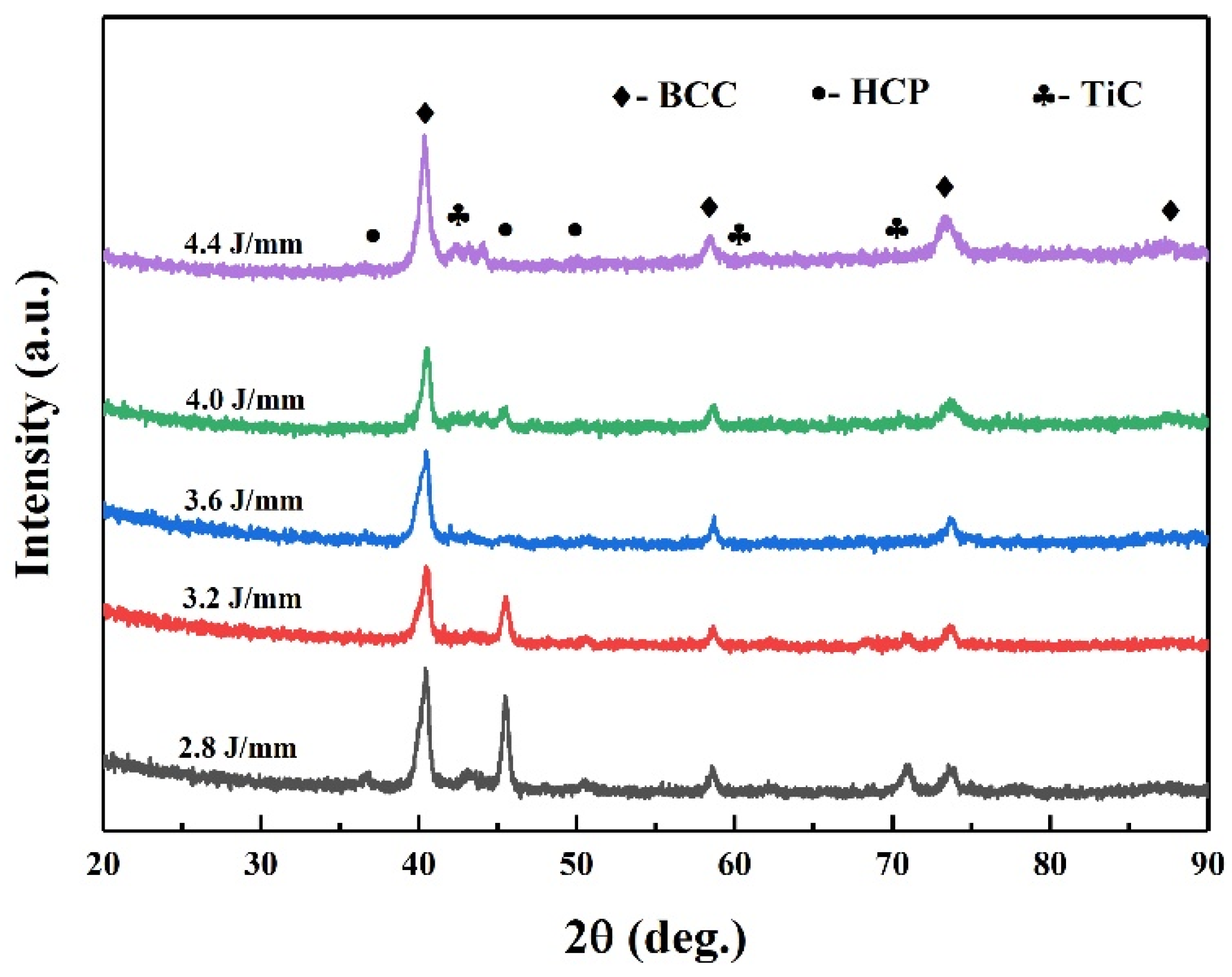
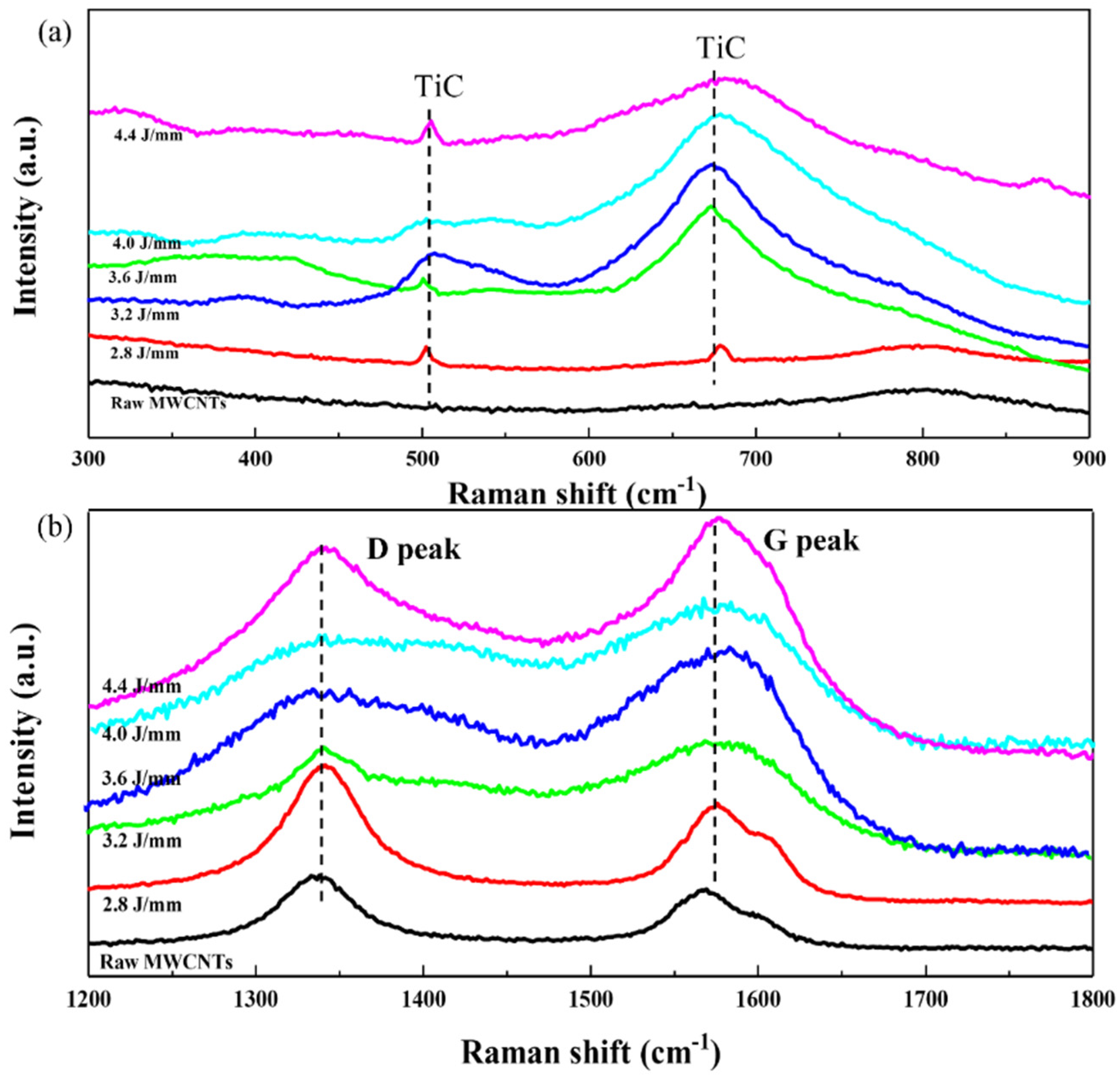
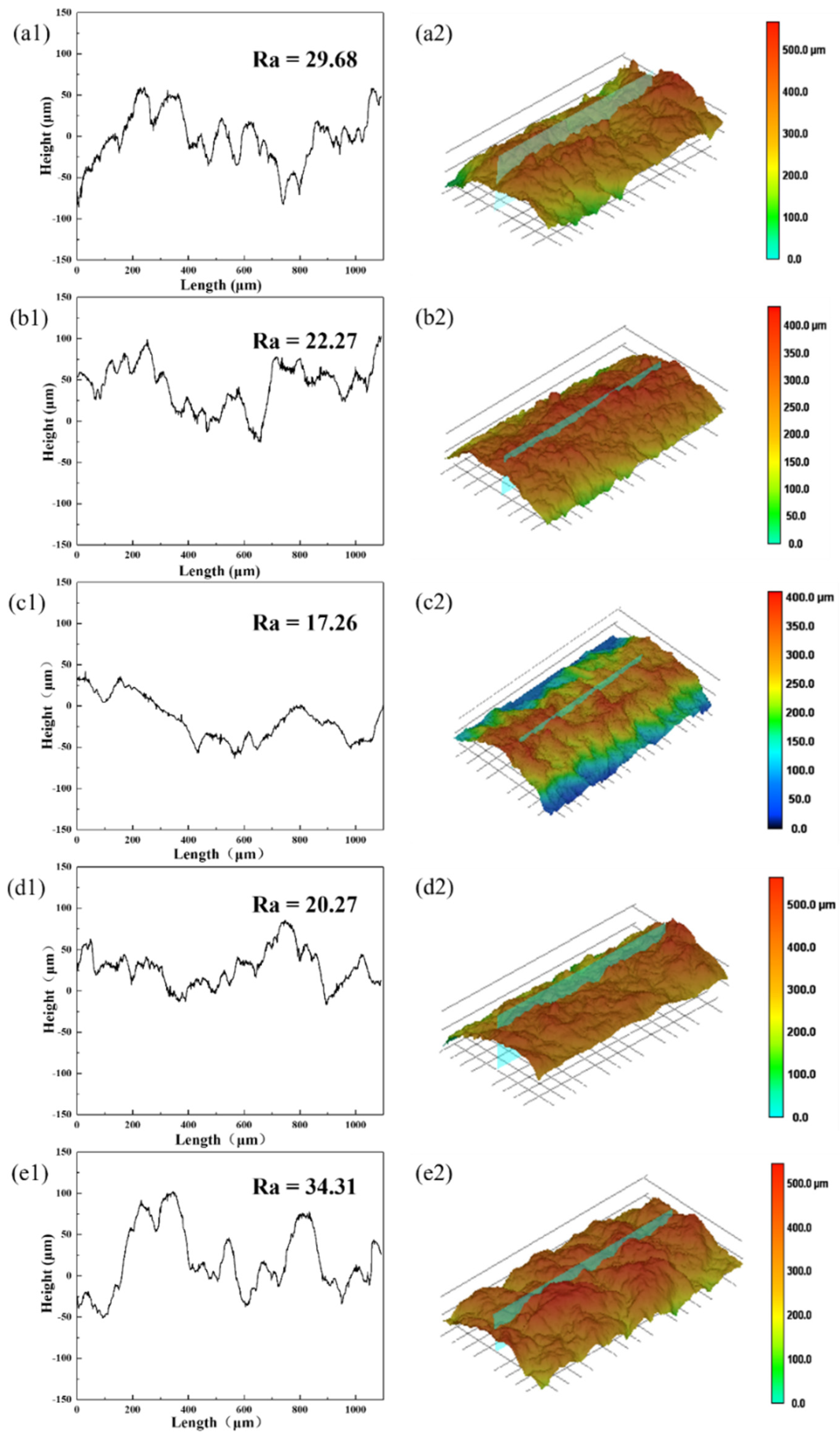

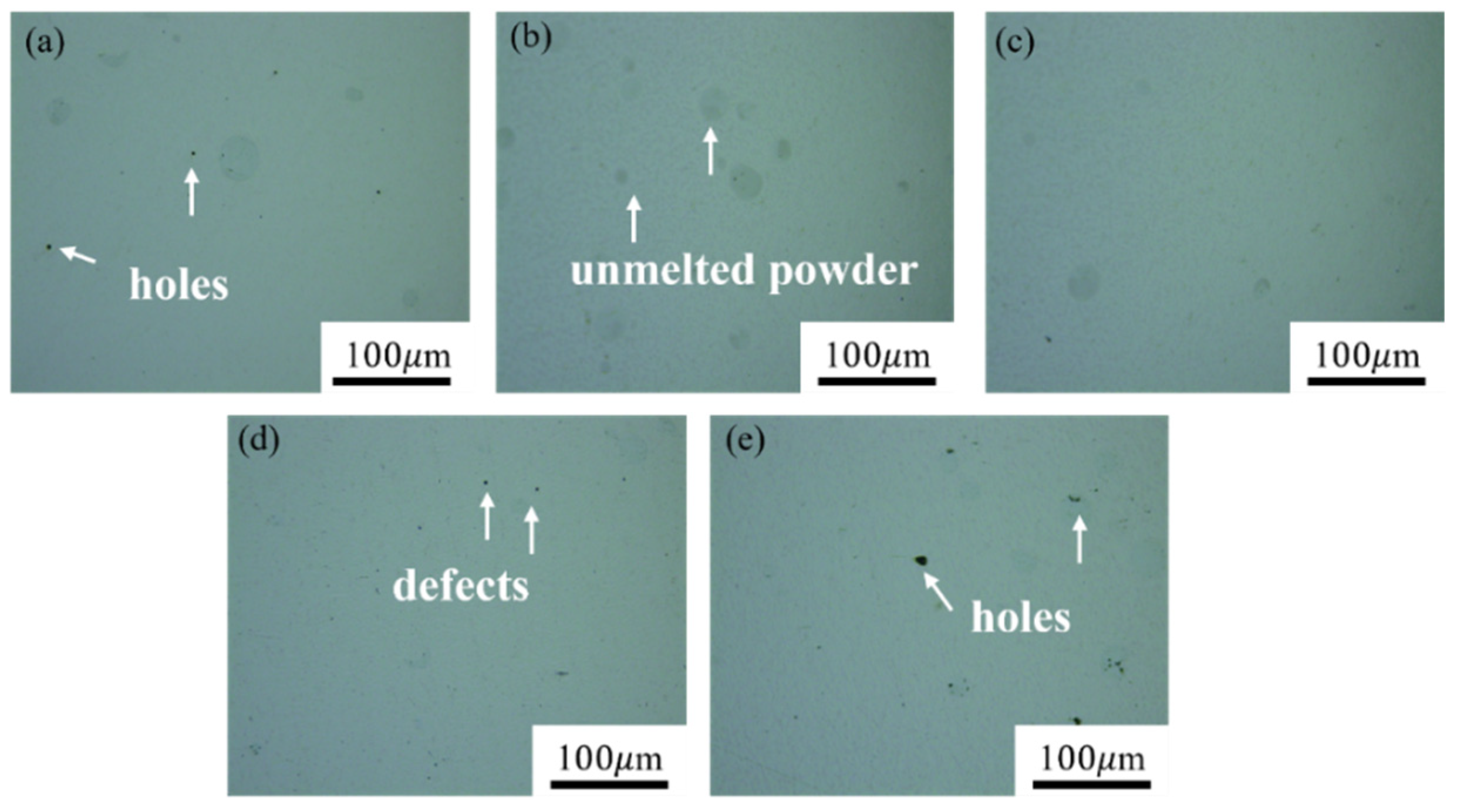
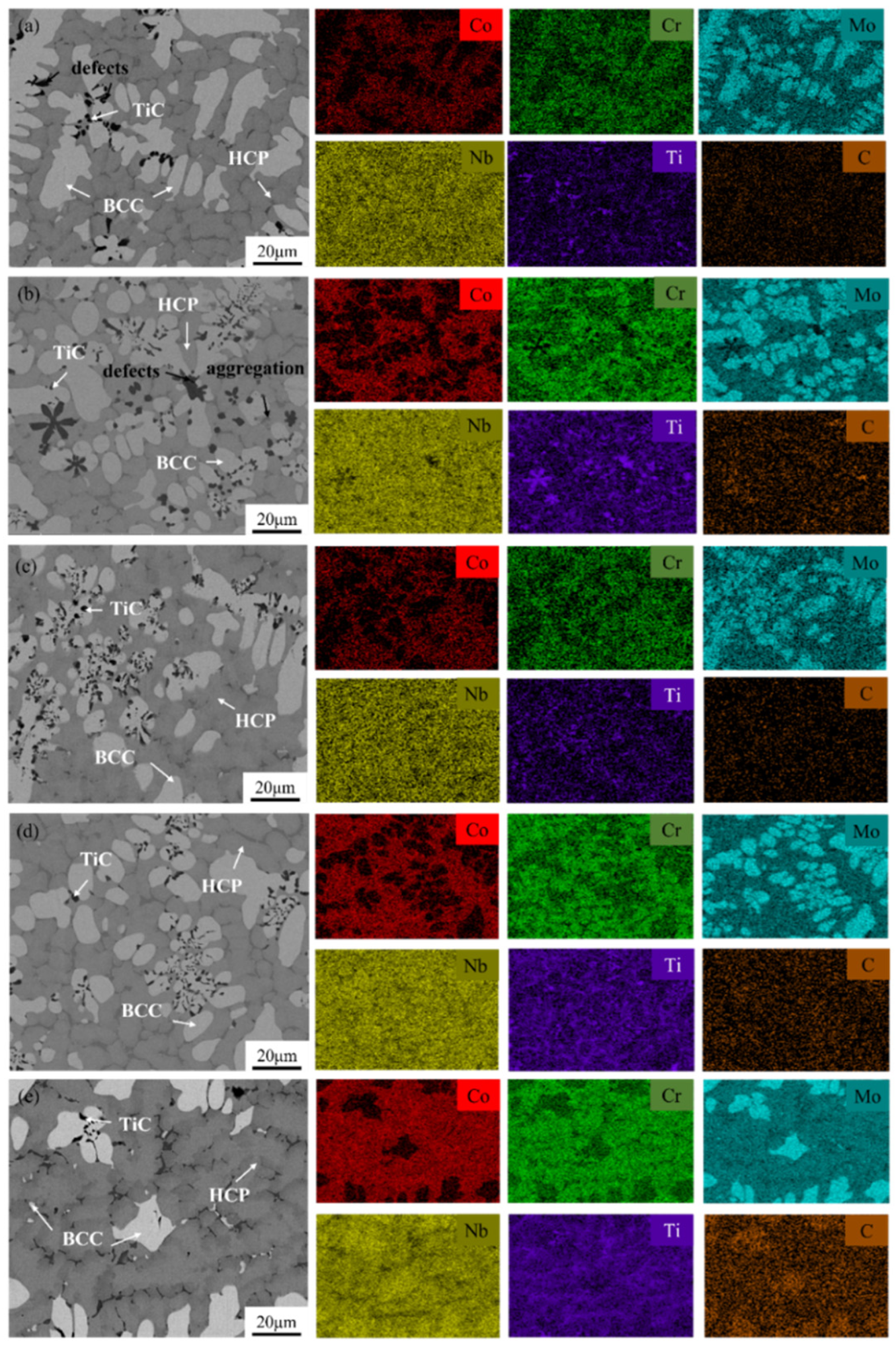
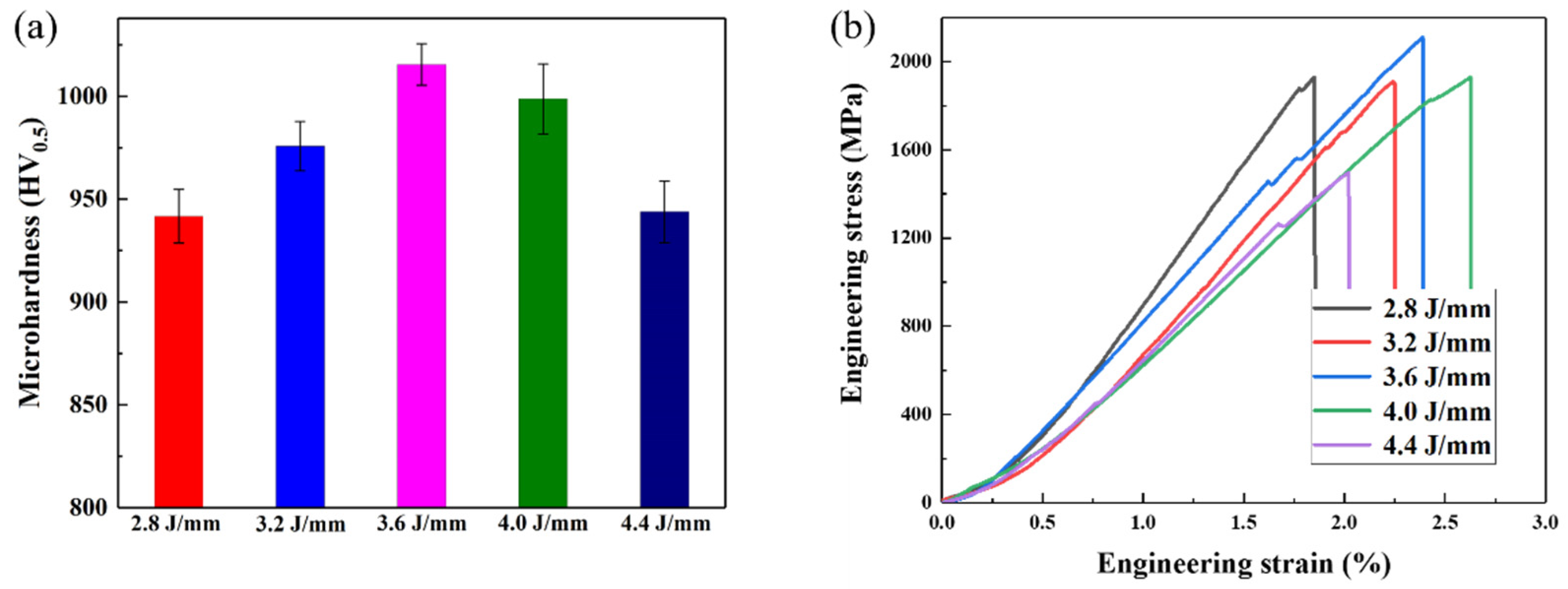
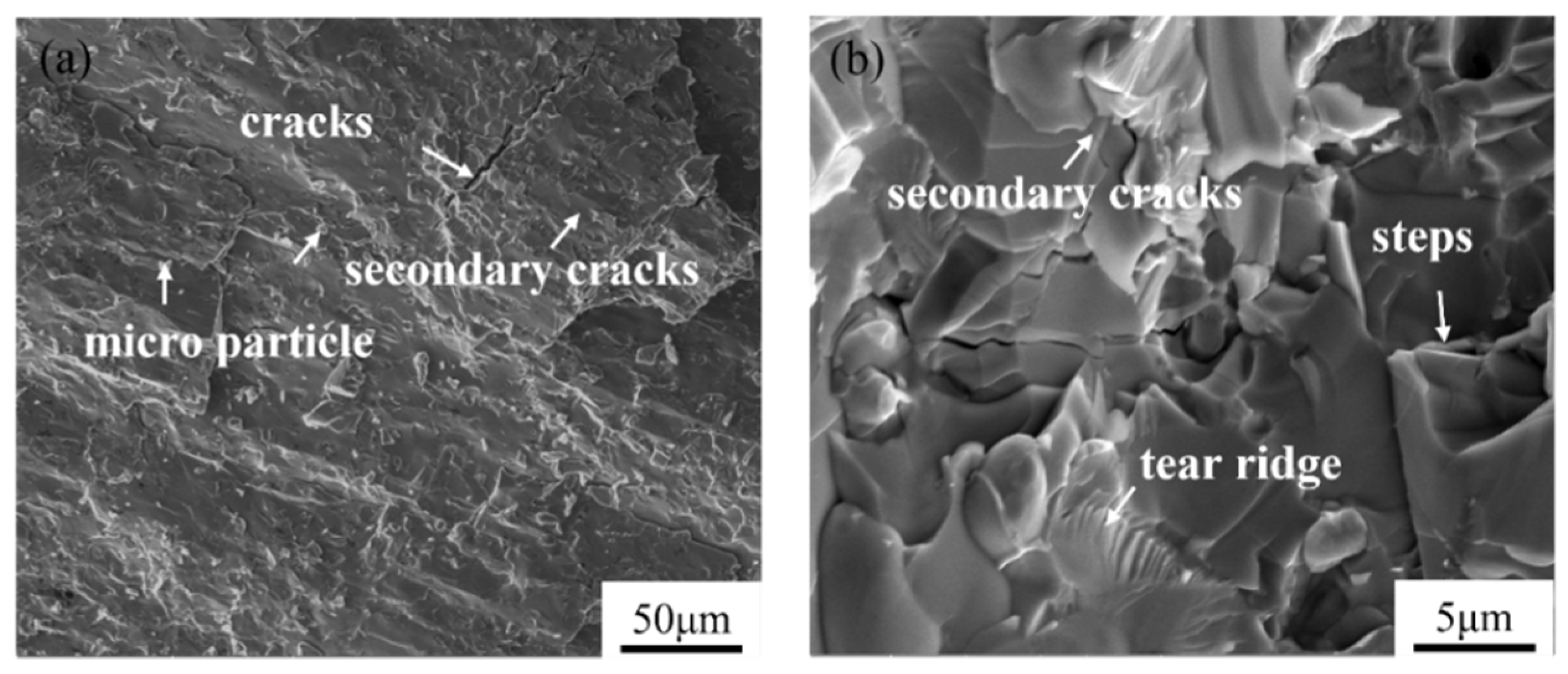
| Elements | Co | Cr | Mo | Nb | Ti |
|---|---|---|---|---|---|
| r/Å | 1.25 | 1.25 | 1.36 | 1.43 | 1.46 |
| Tm/K | 1768 | 2182 | 2896 | 2750 | 1941 |
| /(g/cm3) | 8.84 | 7.19 | 10.23 | 8.58 | 4.50 |
| VEC | 9 | 6 | 6 | 5 | 4 |
| χ | 1.88 | 1.66 | 2.16 | 1.60 | 1.54 |
| Structure at RT | HCP | BCC | BCC | BCC | HCP |
| Structure at Tm | FCC | BCC | BCC | BCC | BCC |
| Laser Energy Density, J/mm | Actual Density, g/cm3 | Relative Density, % |
|---|---|---|
| 2.8 | 7.81 | 90.60 |
| 3.2 | 8.06 | 93.50 |
| 3.6 | 8.28 | 96.06 |
| 4.0 | 8.18 | 94.90 |
| 4.4 | 7.84 | 90.95 |
| Laser Energy Density, J/mm | Microhardness, HV0.5 | Fracture Stress, MPa | Fracture Strain, % |
|---|---|---|---|
| 2.8 | 942 | 1930.60 | 1.85 |
| 3.2 | 976 | 1907.99 | 2.25 |
| 3.6 | 1015 | 2110.50 | 2.39 |
| 4.0 | 999 | 1930.20 | 2.63 |
| 4.4 | 944 | 1496.28 | 2.02 |
Publisher’s Note: MDPI stays neutral with regard to jurisdictional claims in published maps and institutional affiliations. |
© 2022 by the authors. Licensee MDPI, Basel, Switzerland. This article is an open access article distributed under the terms and conditions of the Creative Commons Attribution (CC BY) license (https://creativecommons.org/licenses/by/4.0/).
Share and Cite
Ye, X.; Zhang, M.; Wang, D.; He, L.; Xu, Z.; Zhou, Y.; Ruan, D.; Zhang, W. Carbon Nanotubes (CNTs) Reinforced CoCrMoNbTi0.4 Refractory High Entropy Alloy Fabricated via Laser Additive Manufacturing: Processing Optimization, Microstructure Transformation and Mechanical Properties. Crystals 2022, 12, 1678. https://doi.org/10.3390/cryst12111678
Ye X, Zhang M, Wang D, He L, Xu Z, Zhou Y, Ruan D, Zhang W. Carbon Nanotubes (CNTs) Reinforced CoCrMoNbTi0.4 Refractory High Entropy Alloy Fabricated via Laser Additive Manufacturing: Processing Optimization, Microstructure Transformation and Mechanical Properties. Crystals. 2022; 12(11):1678. https://doi.org/10.3390/cryst12111678
Chicago/Turabian StyleYe, Xuyang, Mina Zhang, Dafeng Wang, Longjun He, Zifa Xu, Yuhang Zhou, Dianbo Ruan, and Wenwu Zhang. 2022. "Carbon Nanotubes (CNTs) Reinforced CoCrMoNbTi0.4 Refractory High Entropy Alloy Fabricated via Laser Additive Manufacturing: Processing Optimization, Microstructure Transformation and Mechanical Properties" Crystals 12, no. 11: 1678. https://doi.org/10.3390/cryst12111678
APA StyleYe, X., Zhang, M., Wang, D., He, L., Xu, Z., Zhou, Y., Ruan, D., & Zhang, W. (2022). Carbon Nanotubes (CNTs) Reinforced CoCrMoNbTi0.4 Refractory High Entropy Alloy Fabricated via Laser Additive Manufacturing: Processing Optimization, Microstructure Transformation and Mechanical Properties. Crystals, 12(11), 1678. https://doi.org/10.3390/cryst12111678







